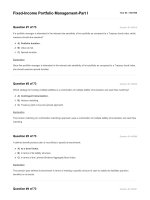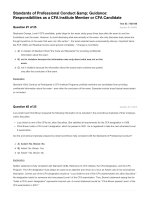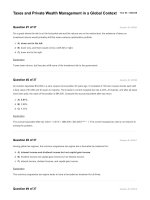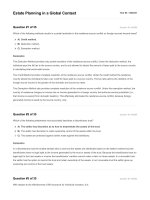Q a schweser self test 08 equity portfolio management answers
Bạn đang xem bản rút gọn của tài liệu. Xem và tải ngay bản đầy đủ của tài liệu tại đây (147.45 KB, 2 trang )
Question #1 of 6
B) Berg is incorrect regarding both statements.
Explanation
Berg is incorrect about both. Berg is wrong on both counts. A conflict between quantitative and
qualitative data is worrisome and would lead to a need for more investigation or excluding that
manager from consideration. Regarding top-down versus bottom-up, Berg is performing the topdown macroeconomic analysis and then relying on managers to add value with individual
security selection. She is using the managers for bottom-up security selection.
Question #2 of 6
A) Topic 4, competitive position.
Explanation
Topic 4, competitive position, is not typically included in a manager questionnaire. The section
not listed in Berg's questionnaire that would usually be listed is resources and research.
Question #3 of 6
C) A principal advantage of performance-based fees is that they help managers retain staff
since they reward good performance.
Explanation
A principal disadvantage of performance-based fees is that the increased volatility of a
manager's compensation can create problems with retaining staff. The other statements are
accurate.
Question #4 of 6
B) Corbin is incorrect regarding both statements.
Explanation
Corbin is incorrect on both points. A contrarian strategy (e.g., investing in recent losers) often
works as well with managers as it does with stocks. Ad-valorem fees are also referred to as
asset under management (AUM) fees and depend on asset value managed, not manager
performance.
Question #5 of 6
A) Only one is correct.
Explanation
Berg is incorrect because the risks are more clearly defined in an alpha and beta separation
approach than in a long-only strategy. Corbin is correct that an alpha and beta separation
strategy could be implemented by taking a long passive position in an index such as the S&P
500 for beta and picking up alpha in a long-short active strategy in a less efficient market.
Question #6 of 6
C) The investor's total return equals the net profit or loss from the long/short position plus the
profit or loss from the futures contract, all divided by the equity the investor put up for the
transaction.
Explanation
The first two are true. The portfolio results are typically compared to the market in which the
investor's capital is invested. The short sale proceeds could be invested in a long position in
equity futures. This is unusual as the only potential alphas would be from shorting overvalued
securities. Usually individual undervalued securities would be purchased to earn alpha on the
long positions as well. But C is possible and not inconsistent with equitizing long/short. The last
statement is partially false. It is true the profits and losses on the individual securities and futures
contract are aggregated. But if contracts are used to create the equity market exposure, the
investor's capital is invested in cash equivalents to fully collateralize the contract position. Thus,
the risk-free rate is also earned.









